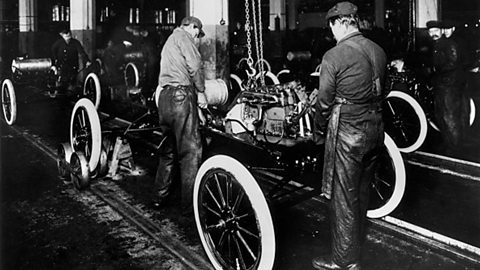Ford and the motor industry
The most significant industry that fuelled the economic boomA period when the economy expands and grows. in the early twentieth century was the motor industry.
The growth of the motor industry

The first car was produced and sold in 1895, but the Ford Motor Company, led by Henry Ford, revolutionised the motor industry. Between 1908 and 1927, the company produced 15 million āModel Tā cars.
The rapid increase in production was due to the use of assembly line A series of workers and machines in a factory by which a succession of similar items is progressively assembled. Each worker would focus on one specific aspect of making the car as the shell moved down a conveyor belt. This cut down the time it took to make a single car from 12.5 hours to just 1.5 hours, with a Model T coming off the production line every three minutes. This was called mass productionWhen the same product is manufactured many times. Many other consumer goods were also produced in this way.
Mass production and the cycle of prosperity
Mass production lowered production costs. This in turn lowered the purchase price of the car for consumers. Cars were now affordable for many working-class Americans. By 1927, the sale price of a new Model T had fallen to more than half of a new model's price when they were initially produced in 1908.
The increase in car sales also stimulated the production and profits of other associated industries, such as oil, leather, glass and textiles. The impact of this chain effect of growth can be illustrated through the cycle of prosperity.
- Mass production leads to increased demand for products and raw material.
- Increased demand leads to more business profits and a need for more workers.
- Workers have more disposable income.
- Workers spend more on consumer products and leisure activities.
Impact on society
This car industry boom changed American society. More roads were built, which improved the transportation network. This prompted new homes and towns to be built in the suburbsThe outskirts of a town or city. People who owned cars could travel to new and different places and enjoyed a higher standard of living. This boosted the tourism and leisure industries.
While Henry Fordās motor factories contributed significantly to the economic boom, some of his actions had a negative impact on society. Within Fordās factories, workers were not allowed to organise into trade unionA trade union is a type of organisation whose main purpose is to represent the interests of employees in a specific type of business. The Ford Motor Company Service Department employed security men who intimidated and used force against union organisers. Ford did not recognise unions until 1941.
Henry Ford held racist and anti-SemiticHostile to or prejudiced against Jewish people. views, and he used his power, wealth and influence to spread these views. In 1918 he bought a newspaper that allowed him to promote and publicise these beliefs to a wide audience, as every Ford car dealer had copies of the paper to give to customers.